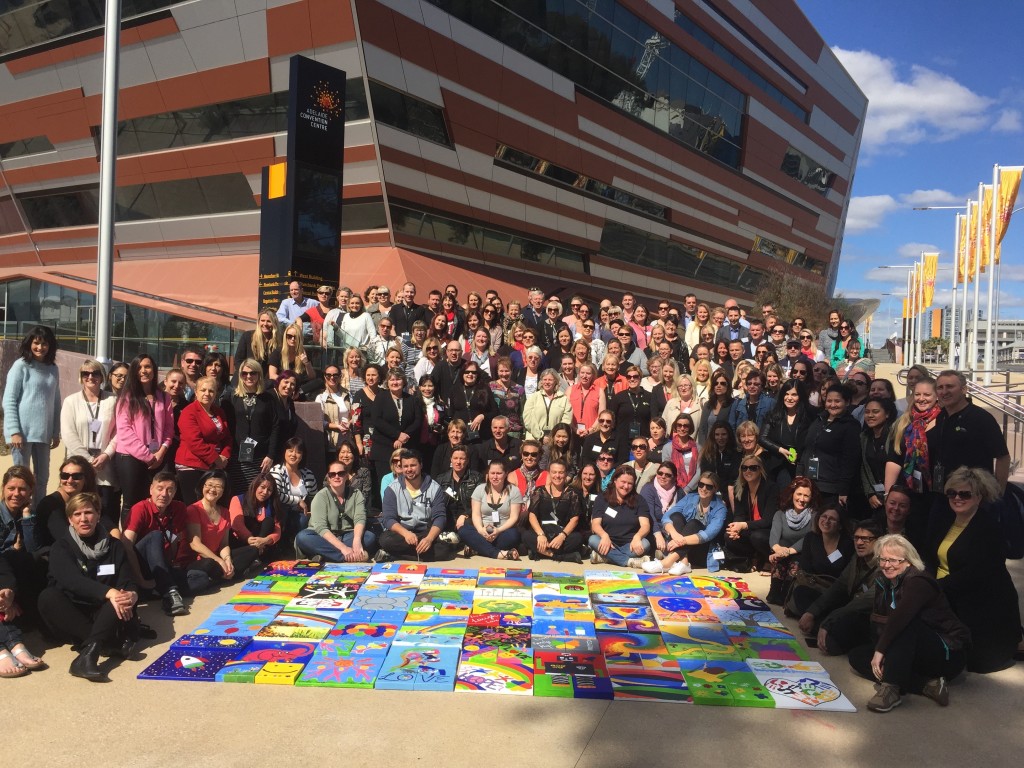Creating the Conditions for Effective Teamwork
in Team Building/by Darren BradyWhat is Effective Teamwork?
Everyone wants to be a part of an effective team or to lead one, but what exactly does it mean for a team to be effective? In most cases, you can assume that an effective team is one which succeeds more often than it fails.
Effectiveness does not mean that there is no failure, but it should mean that the team accomplishes a much higher level of useful work than failed or unhelpful work. An effective team will make long strides towards achieving organisational goals, while an ineffective team will be slow moving or completely stagnant in terms of accomplishments.
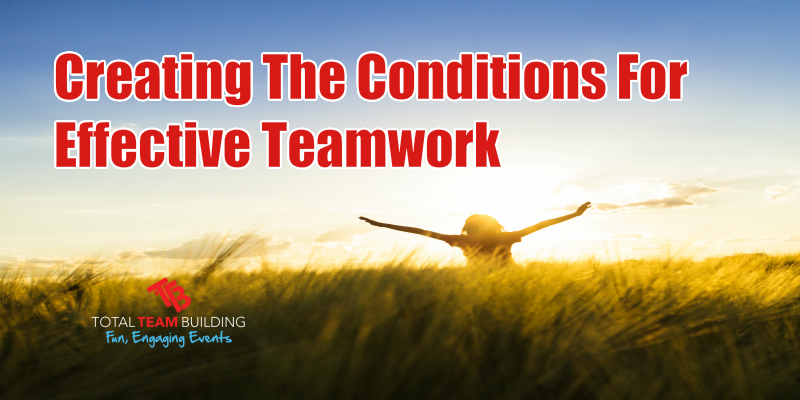
Set Your Team Up for Success
Teams can only become effective if they are created and continued under the right conditions. You can start a team for any purpose and at any time, but if you want it to be EFFECTIVE, you should work to include these elements in the team environment from the beginning to the end of the life of the team:
1. SMART Team Goals
In business, the acronym SMART stands for Specific, Measurable, Attainable, Realistic, and Time-bound. Any goals you set for your team should follow this guideline and fit into every single one of the five categories. Without a clear goal and a vision for what the team is supposed to be doing, team members will become discouraged and will not be as effective at their work.
Teams with clear, SMART goals are usually able to go further than any of organisational teams and will have a greater sense of unity in the pursuit of their accomplishments.
2. Identifiable Roles and Purpose
Every team member should know what their purpose is on the team. There should never be any members who feel as if they are not necessary on the team or that they don’t have a useful job. If they feel this way, it’s possible that they are right and they can or should be removed from the team to make it more efficient.
Define every member’s specific role and make certain that they are aware of it. You might try making an organizational flow chart or information chart to illustrate how each member fits into the team and is supposed to contribute.
3. Diverse Membership
If you set up your team with members who are all very similar or who have similar skill sets, you cannot expect that team to excel in all areas. Create a few layers of diversity by blending together team members from a variety of backgrounds and with a complementary or opposite skills. This will help to ensure that there is enough collective knowledge to get any task done while also cutting down on unnecessary debates over small technicalities.
4. Accountability
How do your team members know what excellent performance means for their team? Will anything happen if they fail or if they succeed? Set up a system of accountability that will help your team to know that their performance is measured and that it matters. Be sure to demonstrate what great performance means and to reward great work from individuals and the team as a whole.
This step can be hard to implement, but it is one of the most important to making an effective team. If you cannot set standards of performance and ensure that they are maintained, performance levels will usually go down over time. On the other hand, if you can keep team members accountable for their own performance and total team performance they will generally maintain a high level or improve over time.
5. Team Member Selection
Just as you should pay attention to diversity, as stated in point #3, you also need to look at the team as a whole and choose members who will work well together. Teams are not just a collection of highly skilled workers thrown together. Selection of members requires more thought than that, as you want to choose those people who will work well with others and will contribute to the group rather than trying to work on their own apart from the team.
6. Appropriate Feedback
It’s been shown that organizations and teams that don’t give enough feedback to their employees tend to have dissatisfied and less effective employees. To solve this problem, make sure you as the team leader are giving feedback whenever possible and appropriate. Don’t wait to an annual performance review, but give constant feedback at goal milestones, every month, or whenever you see the opportunity to praise or train a team member.
7. Collaborative Efforts
Teams without collaboration are absolutely pointless. In an organization where most of the departments or employees are used to working as individuals, you will have to make it clear that your team requires some level of dependency and collaboration for success.
8. Efficient Communication
Closed-off communication and stuffy employee relations can lead to issues with your team. Don’t let communication be the reason for team failure. Instead, promote open communication between yourself and the team as well as between individual members. You can take the lead and host team building exercises, have meetings dedicated to team communication, send out regular information, and take any other steps you see fit to help get your team talking.
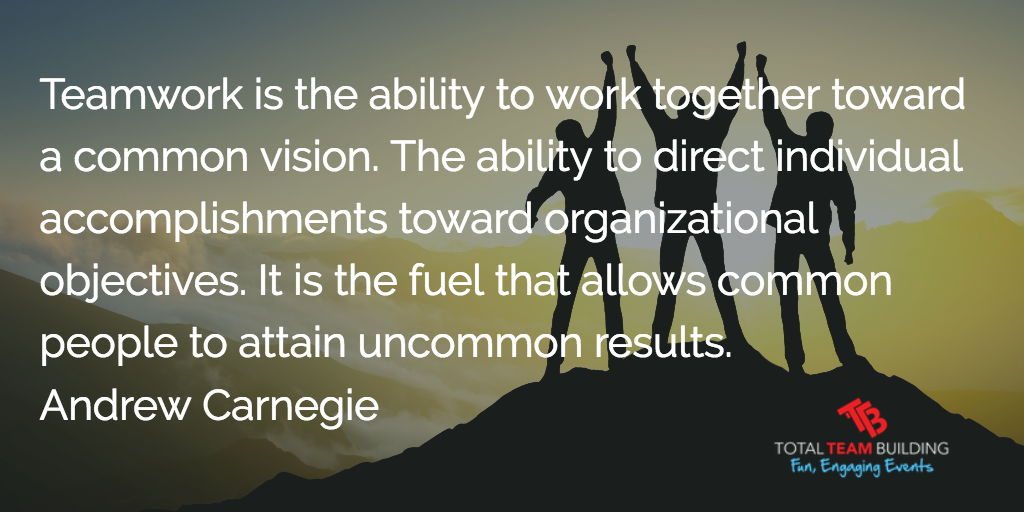
What Can Go Wrong?
Even if you are able to create the perfect conditions for team work to be effective, you have to understand that there might still be problems and difficulties within your team. A team is made up of a lot of different pieces, none of which are perfect. This can lead to conflicts and differences of opinion that might lead to a lot of struggles for your team members.
Conflict is always the most difficult part of working with teams. It can come in all shapes and sizes from personal conflicts between members to professional conflict based on idea disagreement and more. The best way to help alleviate conflicts and make them easier to get through is to continue promoting and facilitating open communication between all members of the team and with team leaders.
Despite the usually negative mental associations with have with conflict, it can actually be turned into a productive part of your team if you know how to handle it properly. Disagreements are not unnatural and they can produce some of the best work you have every done if you can make sure you keep the conversations critical, precise, and professional rather than allowing discussions to get personal and stubbornly opinionated. Two team members shouting or refusing to speak does a lot of harm, but two members debating the merits of an idea can be incredible for your team.
Evaluating Team Effectiveness
At the end of the day, whether your team is effective or not, you need to set up a way to track the performance of the team and how effective it is. If you notice things going poorly, ask yourself which of the above listed elements are missing from your team’s environment and work on improving in those areas. If you are succeeding, record what you are doing and keep building on the foundations to create the best team your organization has ever had!
About Total Team Building
Total Team Building specialise in teams…we facilitate fun and engaging team building activities designed to enhance teamwork, team culture, leadership, communication and collaboration. For more information about how Total Team Building can help you and your team contact us today.
5 Keys To Unlocking Team Performance
in Leadership, Team Building/by Darren BradyDo you have what it takes to lead your team to success? Managing teams is often one of the most difficult parts of holding a leadership position in your workplace. How can you create a successful team and then achieve your business goals together?
Almost any team can be shaped into a successful team through time and effort of the leader. If you have an underperforming team that you want to improve, a new and untested team, or an average team under your direction, try using these 5 best practices to guide your existing team to higher performance levels:
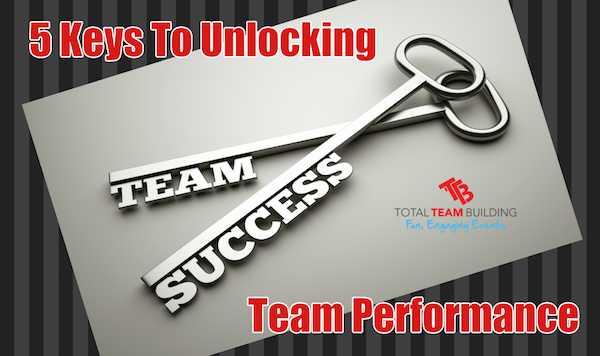
5 WAYS FOR A LEADER TO IMPROVE TEAM PERFORMANCE
1. Make Responsible Goals – Then Share
How can a team be expected to do the right work and make forward progress for the company when they don’t even know where the company wants to go? If higher up, corporate goals are unknown to employees, or if those goals seem completely disconnected to what the employee does every day at work, performance will not be at its highest.
To improve performance, you have to let your team in on what the corporate goals are for the organisation and show them how their individual work contributes to that goal. Without this link, employees can engage in work activities which are unrelated to the company goals or lose their motivation based on a lack of knowledge about how they are helping to advance the company.
For this to work out properly, you will have to get feedback from your team about the daily goals they will be working towards. Are the goals useful for meeting objectives? What might be a better way to do it? Does this metric accurately reflect on the work activities done by employees? Answers to all of these questions get your team thinking about how they can help reach business goals and provide a source of motivation, as the team is now completely aware of how they are contributing.
Avoid vague goals such as “do the best work you can”. The American Psychological Association found in a study that employees who are given such types of goals generally do not perform as well as those given specific and challenging goals.
2. Balance Supervision and Self-Management
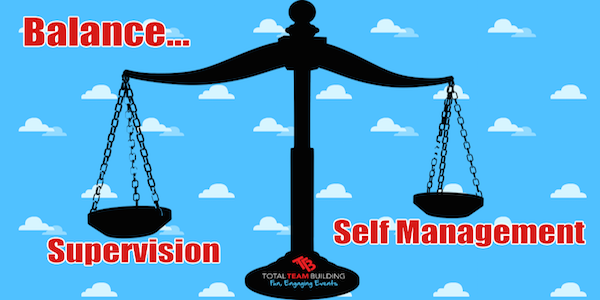
Micro management of your team is a mistake many leaders make when the team is new or when the team is underperforming. Unfortunately, this usually leads to lower performance levels and does nothing to improve the team overall. Pay attention to how your team members work and ask yourself this question: how much autonomy can I provide this team?
Teams made up of self-motivated employees need little to no supervision as long as your give clear direction about what they should accomplish. However, teams with employees that are not self-motivated will require more supervision of daily activities to make sure that goals are being met.
Creating a system of accountability will encourage team members to keep track of their own progress without falling behind on work. If employees are each accountable for what they accomplish during the day and what they add to the overall goals, they are more likely to work well on their own without you having to spend your time checking up on everything your team is doing.
3. Build Trust with Your Team
Teams with higher levels of trust for management and leadership figures are more likely to perform well and to have a more positive impression of the company in general, says a study published by Delft University in The Netherlands. While it’s sometimes hard to see the impact of great leadership, it will show up in the successes of the team. If your employees don’t trust you to make good decisions, to think about their well-being, and to lead fairly and responsibly, they will not give all their efforts to your team projects.
Many team programs focus on building trust between employees without paying much attention to how trusted the manager of the team is! This is an oversight which might end up costing you a lot in the form of wasted time, missed goals, and general team lethargy.
4. Acknowledge Individual and Team Efforts
 When your team members put forth great effort in order to reach a goal, it’s worth recognizing their actions. If you fail to show your employees that you are appreciative of their hard work, they will be much less motivated to work hard in the future.
When your team members put forth great effort in order to reach a goal, it’s worth recognizing their actions. If you fail to show your employees that you are appreciative of their hard work, they will be much less motivated to work hard in the future.
Imagine if employee X and employee Y are on a work team together. Employee X is a hard worker that usually has to pick up the slack for underperforming team members and do extra work in order for the team to accomplish daily goals. Employee Y is an average employee that sometimes underperforms, but usually does nothing more than what is absolutely necessary. If you acknowledge the team’s success as a whole and do never recognize individual contributions, you are subjecting employee X to feelings of frustration and bitterness, as their extra effort seems worthless.
5. Show a Great Example
You as the team leader are the one whom all team members are looking towards for guidance on how to participate in the team. If you are not doing your part or are showing poor working behaviors and a lack of respect for the organisation than many of your team members will follow suit. However, if you are a hard worker and you are modeling good employee behavior, then you will lead your team to follow that positive working example instead.
Applying Team Performance Strategies To Your Own Team
Just as no two people are exactly alike, no team will ever be the same as another. When you are applying these performance improvement strategies, you must be conscious of how they are affecting your team so that you can adjust them to fit your needs more realistically. Don’t be too static and stuck on one way of doing things, or else you may risk ruining team performance and morale even more!
For more information about how Total Team Building can help you and your team contact us today.
The Positive Impact Of Team Building
in Team Building/by Darren BradyResearch has clearly shown that team building has a significant positive impact on teams that find it difficult to work well together. (1) Team building, as the name implies, involves helping employees and management alike learn how to work together as a team. Companies all over the world use a variety of techniques and strategies to help company workers get to know each other and learn how to solve problems, boost personal and collective creativity and work well towards achieving a common goal.
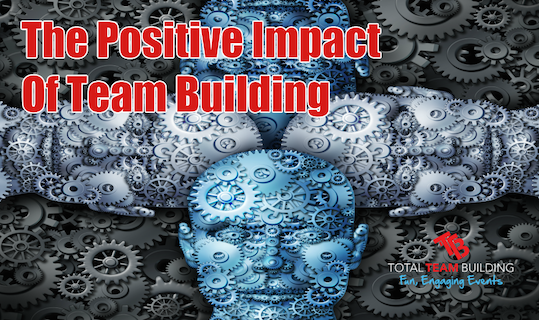
Goal setting and role clarification are particularly effective, as they help each employee better understand his or her individual role, inspire people to set goals, increase motivation to reach company and individual goals and reduce conflict in the office. Teams of ten people or more tend to benefit the most from team building activities; however, such exercises are still effective when used for small groups of people.
What Exactly Does Team Building Do And Does it Work?
The impact of team building is felt in many ways. The following list of benefits that can be gained is by no means comprehensive, but it can give insight into why sacrificing time, resources, and even money for the sake of team-building is well worth it.
Boost Engagement
Recent statistics show that companies with engaged employees earn up to 2.5 times more income than competitors whose employees have a low engagement level. What is more, employees with a high engagement level are 87% less likely to leave a company than employees with a low engagement level.(2)
 Infographic crafted with love by Officevibe, the corporate team building and employee engagement platform.
Infographic crafted with love by Officevibe, the corporate team building and employee engagement platform.
Team building, when done properly, fosters friendships at work. Research has shown that having a good friend at work can boost one’s engagement level by up to 50%.(3) Team building exercises that are effective in helping employees make friends with workmates include a weekly or monthly “Happy Hour”, a company volunteer project and seminars hosted in turn by various employees.
Another important aspect of team building involves building trust between office supervisors and managers and those who work under them. A 2015 Gallup study shows that a highly engaged leadership team can boost employee engagement by up to 39%. Company leaders can improve engagement by setting individual and company goals in collaboration with employees, being transparent about company progress and creating a company culture. Good team-building exercises that would boost manager-employee friendships include group challenges with mixed teams of managers and employees who would be required to work together as equals to solve a problem or win a game.
Improve Communication Skills
Over 85% of all workplace failures have been attributed to lack of collaboration and/or ineffective communication. Additionally, a recent survey revealed that fewer than 50% of employees believe that their organization discusses issues in a truthful, effective manner. (4)
Team building activities that require team members to communicate with each other to resolve a problem or win a competition can be effective in helping employees become effective communicators. At the same time, these activities should be coupled with office policies that promote team bonding.
One idea that has proven to be effective with a large bank was to rearrange the coffee break schedule so that each call center team could take a break together as a group. This simple move lowered the average call handling time by up to 20% and increased employee satisfaction by more than 10%, leading to a profit projection increase of more than $15 million. (5)
Team building involving social media platforms can also be effective, especially if a large number of office workers are millennials. One recent study shows that nearly half of all Millennials support the use of social tools to increase workplace collaboration. What is more, the overwhelming majority of young people interviewed in this study would be willing to pay for such tools out of pocket. (4)
Improve Creativity
Many of the world’s largest companies realize that creativity can significantly boost a company’s bottom line. Google, 3M and Gore and Associates all allow time for employees to get away from their regular jobs and come up with new ideas, procedures and products. What is more, these large companies all credit “company creativity time” as being the inspiration behind some of their most successful products.(6)
Team building improves creativity in two ways. First of all, it puts employees in a new environment and requires them to perform tasks and/or solve problems that are not a part of their day to day work routine. Second, creativity-based team building exercises make it clear to employees that company managers and executives value creativity.
It can be worth it for a company to hold monthly or annual team building events at a venue that is far removed from the office environment. A hotel conference room can be a good place to hold creativity-based team building games and activities; alternatively, an outdoor setting can be ideal if all employees are physically fit and able to engage in active team sports and activities.
In Summary
While hiring the right employees is certainly important, it is clear that choosing good people for your company is not the only key to success. Helping your employees work well together can not only boost your bottom line but also reduce workplace friction, prevent good people from leaving your company, help your company solve problems more easily than would have otherwise been possible and even lead to the creation of new goods and/or services that will propel your company forward into the future.
Team building events help employees get to know each other, learn how to work together and make it easy to communicate about workplace issues. However, knowing which team-building strategies are right for your company can be challenging. That is why it can be a good idea to work with professionals who specialize in team building events, activities and programs. Getting professional help in this field will ensure that your team is effective and that employees enjoy working with you and their colleagues to try new ideas, solve problems and reach company and personal goals.
If you would like to speak to us about how we can help you with your team, Contact Total Team Building today!
Sources
(1) https://en.wikipedia.org/wiki/Team_building#Effect_on_performance
(2) https://www.officevibe.com/blog/disengaged-employees-infographic
(3) http://blog.desktime.com/2016/02/11/team-building-events-that-work/
(4) http://blog.clearcompany.com/7-workplace-collaboration-statistics-that-will-have-you-knocking-down-cubicles
(5) https://hbr.org/2012/04/the-new-science-of-building-great-teams
(6) https://www.psychologytoday.com/blog/the-power-daydreaming/201002/sparking-creativity-in-the-workplace
Effective Strategies for High Performance Teams
in Team Building/by Darren BradyIf the last decade of business research has taught us anything, it’s that if you want to know how to increase productivity, raise job satisfaction, and create a healthy working environment you need to learn about creating and managing a team. Effective, high performance teams are the one thing that almost all top companies have in common.

Not all organisational teams can be considered as high performance teams. High performance teams are those that are committed to working together in order to accomplish the business goals, individual goals, and personal goals. These teams are able to improve your business in a way that no ordinary company team or individual workers would be able to.
In this article you can learn about how to make your own high performance teams and how to manage them in a way that keeps their performance at an elevated level.
HOW TO CREATE A TEAM
Not every team has the capability to be a good team. There must be a proper mix of people and talents if you intend to create a team that will perform well. Building a team can be the hardest part of team management, as you must be able to make a calculated guess at how certain members will work together. If a particular member is not a good contributor to the team, you must be able to evaluate if they are a necessity in that team and figure out if you can replace them or not.
BEST PRACTICES: CREATING A HIGH PERFORMANCE TEAM
- Look for the best workers inside and outside of the company.
High performers may take some time and some work to acquire, but the difference between them and an average performer can make a lot of impact on how well the team works. Taking the time to look for high performers to add to your team is a good way to use your time to create a great team.
- Find workers with skills that match your team’s needs.
Don’t add anyone to the team unless their knowledge and skills are needed for the work. If there are already enough team members working in those same skill areas, you may create a frustrating situation where there is too much labor and not enough work to be done. Nothing creates disgruntled employees faster than not being needed for the job.
- Prioritise a healthy teamwork environment to achieve results.
Instead of trying to force new members onto a team, think about what s best for the team. Will this new member add or detract from the current teamwork level? Are they a good fit with the other members? The team mix is very important if you want to have a great team, so think about this before you add a new team member.
- Remove or replace non-productive team elements.
On the other hand, if someone on the team is not being productive and not performing well, it might be a good idea to remove or replace them. When other members have to put in extra efforts to cover the incomplete work from one member, they can easily become very dissatisfied with the team itself and the whole performance level will be brought down.
HOW TO MANAGE A TEAM
Even if you have created the “perfect” team, your job is not over as a manager. You are now responsible for managing that team in a way that will help them to stay productive and keep up the high performance. Many times if a high performance team is managed improperly their performance can suddenly become quite average or even poor. It’s up to you to make sure that you are getting the best results from your team and creating an atmosphere in which high performance teamwork can thrive.
BEST PRACTICES: MANAGING A HIGH PERFORMANCE TEAM
- Give recognition and credit when it is due.
When the entire team or any individual on the team does great work or goes beyond their responsibilities to get something done, acknowledge their efforts. This can be accomplished by something simple like audible recognition during a team meeting or something more such as an individual or team reward.
- Delegate responsibilities and avoid micromanagement.
One of the worst things you can do as a manager is to try to manage everything the team is doing. If you want your high performers to do the best job they can, you have to let them have some space and responsibilities. Delegate some tasks and expect them to be done well; there is a good chance that your high performance team will not disappoint.
- Involve team members in the goal-making process.
How can you help employees become more engaged in the work that needs to be done? By including your team members in the process of making goals, they will know that their thoughts and opinions are valued by the organisation. This can help increase employee engagement in the goals of the business.
- Create measurable progress assessments and keep team members accountable.
This step goes hand-in-hand with delegation and goal-making. You will want to make sure there are measurable performance matrixes set up so that each employee can know what they have accomplished and what still needs to be done. Doing this will help you as the manager make sure that work is getting done by your team without any micro-management from you. It also allows team members to keep themselves and each other accountable for their work.
- Promote organisational goal transparency.
True engagement in the work means that employees must be able to see how the work they do actually affects the organisation as a whole. Goal transparency can help with this. To achieve goal transparency you should be able to show your employees what the strategic goals of the organisation are, the operational goals of your sector and other sectors of the business, and then demonstrate in a logical way how these things all work together to improve the business.
- Give useful and relevant feedback.
Make sure your employees always get the necessary feedback to perform well at their job. If they do not know that they are doing well or poorly, there is no way for them to be confident in their work. Feedback can help your team members become confident that their contributions are relevant and appropriate, giving them a greater sense of being appreciated and useful.
TYING IT ALL TOGETHER
Both creating and managing a team are important skills to learn if you want to keep a high performance team in your organisation. If you cannot create a good team mix, it’s highly unlikely that any amount of great management will turn the team into high performers. On the other hand, you could put together the perfect mix of people, but due to mismanagement they might become disgruntled and highly dissatisfied with the work, leading them to do mediocre work as a team.
For the most ideal results, you’ll need to create a good mix of people for your team and then adapt your management style to deal with the team’s needs most effectively. If you can effectively apply these tips, you may be able to create and manage your own high performance team in your business.
Employee Engagement The Key To Happiness And Organisational Performance.
in Culture Change, Motivation, Team Building/by Darren BradyThere’s a good reason Google received almost 1.3 million applications from people hoping to gain employment with the tech giant.
Google’s philosophy is to “create the happiest, most productive workplace in the world,” company spokesman Jordan Newman told the New York Times.
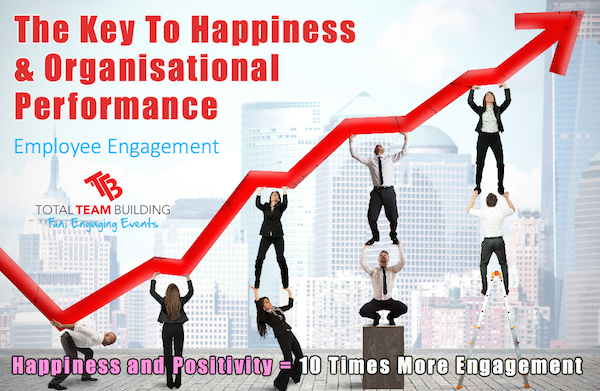
For the sixth consecutive year, Google leads the pack as number one on Fortune’s list, the 100 Best Companies to Work For.
Beyond the bounty of perks offered to Googlers, it’s a happy environment that ignites creativity, cultivates innovation, and most importantly, boosts productivity.
Teams are the foundation of its success and the Internet juggernaut spares no expense at keeping its employees happy. It even has a People Operations department with experts whose jobs are to ensure employees stay happy and engaged.
Team building is part of Google’s culture. Having fun together fosters a sense of unity and among employees and creates that engaging environment that people enjoy.
Engaged workplaces are more profitable, have positive customer feedback and a higher rate of employee retention.
Happiness = Success
In a comprehensive analysis of 225 studies, researchers Sonja Lyubomirsky, Laura King, and Ed Diener found a strong connection between happiness and success. The research that combines neuroscience, management studies and the bottom lines of international organizations shows that happiness and positivity in the workplace results in:
- 3 times more creativity
- 31% more productivity
- 10 times more engagement
“People who cultivate a positive mind-set perform better in the face of challenge. I call this the “happiness advantage”—every business outcome shows improvement when the brain is positive,” Shawn Achor, best selling author and psychologist, writes in Positive Intelligence, published in the Harvard Business Review (HBR).
Engaged employees are psychologically invested in the organization and care about its overall success. Disengaged employees just don’t care.
The cost of disengagement can cripple an organization’s level of performance. According to Gallup, How to Tackle U.S. Employees’ Stagnating Engagement, actively disengaged people cost the American economy up to $550 billion per year in lost productivity.
It’s not that surprising.
In a lifetime, people spend an average of 90,000 hours at work – that’s almost 11 years of continuous days in an office. Crestfallen workers, trapped in an unhappy environment, are more likely to produce disappointing results.
Creating that positive work environment that engages employees is key to happiness and organizational performance.
Team building is a great way to maximize employee engagement. If co-workers recognize each other’s strengths and learn to collaborate as a team to reach an equal goal, chances are they will feel more connected and communicate more effectively.
A 2010 study in the International Journal of Business Management shows that employee engagement is mostly found in high growth companies.
The study, Employee Engagement, the Key to Improving Performance, reports a: “positive relationship between employee engagement and organizational performance outcomes: employee retention, productivity, profitability, customer loyalty and safety. Research also indicates that the more engaged employees are, the more likely their employer is to exceed the industry average in its revenue growth.”
Google, a dominant force in the tech industry, is proof. The brand is less than 20 years old and generates more than $45 billion annually.
Perhaps you remember the following story that clearly demonstrates the Google culture: building teams with highly-engaged people who are fully committed to the company’s overall performance and growth.
In 2002, co-founder Larry Page is famously known for posting a printout of results from Google AdWords in a kitchen at Google that said: “THESE ADS SUCK.”
Instead of blasting, reprimanding or firing the AdWords team, Page had full confidence that the talented team would correct the problem.
The HBR writes in The Google Way of Attacking Problems: “In most companies, this would be seen as cruel — an arrogant executive publicly humiliating his hapless employees for shoddy work — but not at Google. In fact, his unusual act was a show of confidence, defining a tough problem that he knew his talented engineers would want to solve.”
Page was right. He understood his employees and knew how to motivate innovation. By Monday morning, “a group of engineers sent out an email with a solution that not only resolved the AdWords problem, but helped transform Google into a major money machine,” HBR writes.
Motivate Your Team
Is your company looking to create that environment that boosts engagement, promotes innovation and maximizes productivity? Discover the internal motivators of your team and understand how their values align with the overall goals of your organization.

33 Easy Ways to Motivate Your Creative Employees
If your looking to motivate your staff or would like them to be more actively engaged so they connect, communicate and collaborate then let us design a unique program that taps into the key motivators of your workforce with fun, engaging team building events. Give Total Team Building A Call Today.
Sources
- Fortune Magazine, 100 Best Companies to Work For: http://fortune.com/best-companies/google-1/
- Google People Operations: http://www.google.com/about/careers/teams/people-operations/
- Success with Five Positivity Habits: http://executiveeducation.wharton.upenn.edu/thought-leadership/wharton-at-work/2014/03/positivity-habits
- HBR, Shawn Achor: https://hbr.org/2012/01/positive-intelligence
- Gallup, How to Tackle U.S. Stagnating Employee Engagement: http://www.gallup.com/businessjournal/162953/tackle-employees-stagnating-engagement.aspx
- International Journal of Business Management, Employee Engagement, the Key to Improving Performance: http://www.ccsenet.org/journal/index.php/ijbm/article/viewFile/6745/6332
- Harvard Business Review, The Google Way of Attacking Problems: https://hbr.org/2014/12/the-google-way-of-attacking-problems
- New York Times, Jordan Newman quote: http://www.nytimes.com/2013/03/16/business/at-google-a-place-to-work-and-play.html?_r=0
- 33 easy ways to motivate your creative employees: http://www.companyfolders.com/blog/best-ways-to-motivate-employees
Team Building to Create Happy Employees
in Team Building/by Darren BradyIt’s not often that employees of a multi-billion dollar company will broadcast their workplace satisfaction by creating a YouTube video on happiness. It happened last year when flight staff from Virgin America created a video to Pharrell Williams’ song, “Happy.”
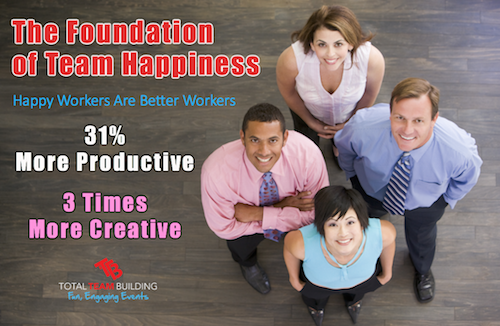
Richard Branson is doing something right to have his staff pay homage to his style of leadership with a crazy dance to the happiness song on a Virgin plane.
What is he doing?
Branson puts his employees first. Virgin invests in employees with regular team building events to increase engagement and strengthen relationships among employees, which is critical in developing a highly competitive organization.
“Clients do not come first. Employees come first. If you take care of your employees, they will take care of your clients,” said Branson, who credits his employees as being the heart of his billion-dollar empire.
Like Branson, some of the best leaders of the most successful organizations are known for their unconventional way of running a business – looking beyond strategic goals and quarterly results. Employees come first.
Successful organizations profit from team building exercises that fuel stellar employee performance, resulting in exemplary customer service.
The Foundation of Team Happiness
Building a brand on the foundation of happiness creates passionate and engaged employees that drive the success of an organization.
The foundation of happiness is a philosophy that creates an employee-centric management strategy that fosters innovation, passion and engagement from workers, which has a markedly positive effect on customer relations.
And companies that have a reputation for practicing the happiness factor are the ones that experience phenomenal growth.
According to Being Happy at Work Matters, published by the Harvard Business Journal, happiness counts for success. “Happy people are better workers. Those who are engaged with their jobs and colleagues work harder — and smarter.” Conversely, those disengaged are “sabotaging projects, backstabbing colleagues, and generally wreaking havoc in their workplaces.”
Shawn Achor, Best Selling author, psychologist and Harvard University Researcher, says a productive brain is sparked by positivity in the present. In fact, a comprehensive analysis of 225 studies shows that happy employees are 31% more productive and three times more creative.
Achor, known for The Happy Secret at Work – one of the top most 20 viewed Ted Talks, says when your brain is at positive, it “…performs significantly better than at negative, neutral or stressed. Your intelligence rises, your creativity rises, your energy levels rise. In fact, we’ve found that every single business outcome improves.”
You might find that high-performing individuals in leading organizations will tell you that success does not drive happiness but that success is driven by happiness.
Inspiring Engagement with Cohesiveness
Creating a cohesive team across each level in a company anchors trust, opens communication and inspires innovation. More importantly, team building allows employees to experience and overcome challenges outside the work environment, where everyone from senior executives to direct reports, are on an equal playing field.
And it creates a happy work environment.
Just ask the staff at Virgin Atlantic.
Create a culture of happiness within your team! With more than 20 programs and activities to choose from let Total Team Building help you engage your staff…Contact Us Today!
SOURCES:
Harvard Business Journal, Being Happy at Work Matters: https://hbr.org/2014/11/being-happy-at-work-matters
Virgin Atlantic, Happy song: https://www.youtube.com/watch?v=iJnJ0kanTI4
Wharton University of Pennsylvania, Executive Education, Improve Productivity and Success with Five Positivity Habits: http://executiveeducation.wharton.upenn.edu/thought-leadership/wharton-at-work/2014/03/positivity-habits
Shawn Achor, The Happy Secret at Work, Ted talks: https://www.ted.com/talks/shawn_achor_the_happy_secret_to_better_work/transcript?language=en
Travel Managers Charity Team Event
in Adelaide/by Darren BradyTravel Managers contacted us looking for a charity based team event to be conducted at their annual conference in Adelaide. They wanted to create and donate some artwork to the little heroes foundation to go in the new $4 million dollar robotic rehabilitation centre and research unit for seriously ill children at the Womens and Childrens Hospital.
Naturally our Raw Canvas program was a perfect match and we were challenged with the task of coming up with a tailored concept and design that would incorporate and engage 220-240 delegates for this two and a half hour activity.
We divided the delegates into 36 teams and each team was responsible for painting 1 x 16”x 16” and 2 x 8”x 8” canvases. In total our artwork would consist of 108 canvases and when put together would make a huge collage artwork like the image below to be hung in the foyer of the new robotics centre.
Design Brief
The design brief given to each team was that they needed to create a collage type artwork that would be enticing to both children and adolescents for when they come into the centre. The theming of their artwork had to be based around the themes of:
- Movement
- Fun
- Children
- Motivation
- Inspiration
They were given full creative licence to inspire with their designs. The style of art and how they interpreted the themes was totally up to them.
The End Result
After an energising start to the morning with our famous Rock, Paper, Scissors challenge, all teams knuckled down and got their creative juices flowing producing some amazing pieces of art. Everyone was engaged and had a fantastic time as their creations came to life. Seeing all artworks come together at the end was truly amazing. See for yourself – Check out the video below
TTB interviewed on 882 6PR Radio
in Team Building/by Jason TheakerJason Theaker was this week interviewed on Perth’s Baz and Millsy’s 6PR breakfast radio program. The topic of team building came into question when prime minister Tony Abbott suggested that the next time all the State Premiers catch up they will be going on a leadership retreat. Have a listen to how the interview panned out?


